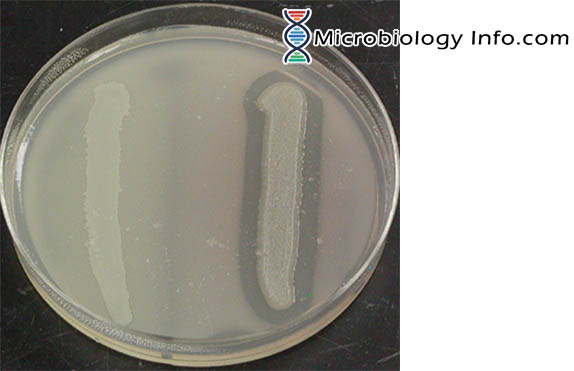Lipids are high-molecular-weight compounds possessing large amounts of energy. Once assimilated into the cell, they are metabolized through aerobic respiration to produce cellular energy, adenosine triphosphate (ATP). The components may also enter other metabolic pathways for the synthesis of other cellular protoplasmic requirements.
However, before their assimilation by bacteria, they need to be degraded. The degradation of lipids such as triglycerides is accomplished by extracellular hydrolyzing enzymes, called lipases (esterases), that cleave the ester bonds in this molecule by the addition of water to form the building blocks glycerol (an alcohol) and fatty acids.
Objectives
- To determine the ability of the organism to hydrolyse lipid.
- To identify bacteria capable of producing the exoenzyme lipase.
Principle
In this experimental procedure, tributyrin agar is used to demonstrate the hydrolytic activities of the exoenzyme lipase.
The medium is composed of nutrient agar supplemented with the triglyceride tributyrin as the lipid substrate. Tributyrin forms an emulsion when dispersed in the agar, producing an opaque medium that is necessary for observing exo- enzymatic activity.
Following inoculation and incubation of the agar plate cultures, organisms excreting lipase will show a zone of lipolysis, which is demonstrated by a clear area surrounding the bacterial growth. This loss of opacity is the result of the hydrolytic reaction yielding soluble glycerol and fatty acids and represents a positive reaction for lipid hydrolysis.
In the absence of lipolytic enzymes, the medium retains its opacity. This is a negative reaction.
Media:
Tributyrin agar: Peptic digest of animal tissue 5.0 gm/L, Yeast extract 3.0 gm/L, Agar 15.0 gm/L, Final pH ( at 25°C) 7.5±0.2
Method
- Inoculate the tributyrin agar medium with single line streaking of organism.
- Incubate anaerobically in a gas pak jar immediately after streaking and transfer into the incubator maintained at 35-37oC for 24-48 hours for anaerobes and for aerobes incubate the plate at 35-37o C for 24-48 hours.
- Examine the tributyrin agar plate cultures for the presence or absence of a clear area, or zone of lipolysis, surrounding the growth of each of the organisms.
Expected Results

Tributyrin agar plate. No Lipid hydrolysis on left; lipid hydrolysis on right.
- Positive test: Formation of a clear zone around the bacterial growth
- Negative test:No clear zone around growth.
Uses
- Helpful in identifying bacteria that secrete lipase, including members of Enterobacteriaceae, Fusobacterium, Propionibacterium, Clostridium, Pseudomonas, Mycoplasma, Corynebacterium, and Staphylococcus.
- For the detection and enumeration of lipolytic microorganisms in food and other material.
Limitations
- It is recommended that biochemical, immunological, molecular, or mass spectrometry testing be performed on colonies from pure culture for complete identification.
References
- Cappuccino J.G. and Sherman N. 2008. Microbiology: A Laboratory Manual, 8th ed. Pearson Benjamin Cummings, San Francisco, CA, USA.
- Brown A.E. 2009. Benson’s Microbiological Applications: Laboratory Manual in General Microbiology, 11th ed. McGraw-Hill Companies, New York, NY, USA.
- delrio.dcccd.edu/jreynolds/microbiology/2421/lab_manual/lipid.pdf
- https://www.sigmaaldrich.com/content/dam/sigma-aldrich/docs/Sigma-Aldrich/Datasheet/1/91015dat.pdf
- www.srlchem.com/products/product_details/productId/3716/Tributyrin-Agar-Base-w-o-Tributyrin
